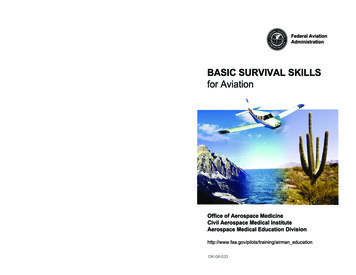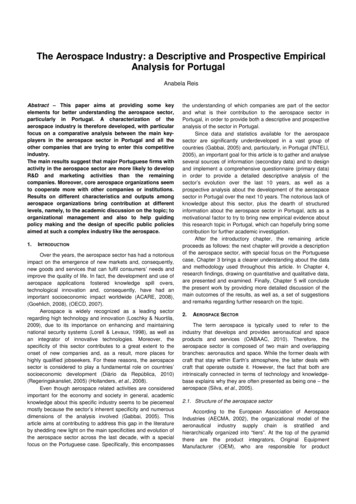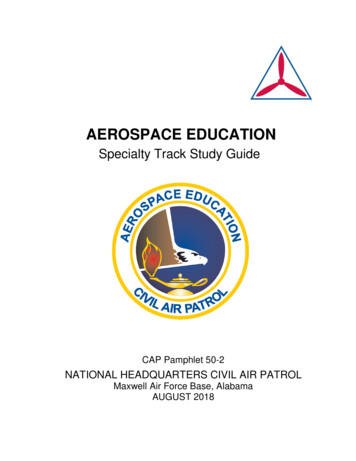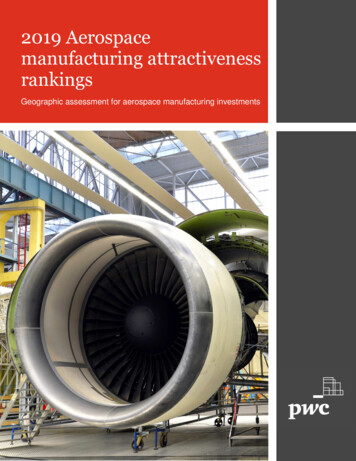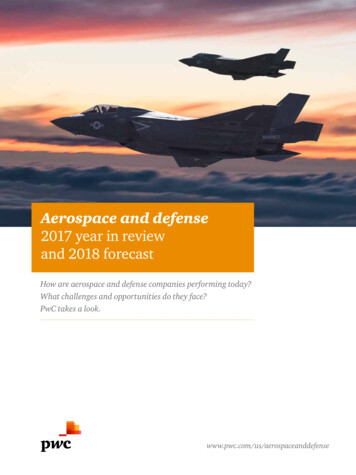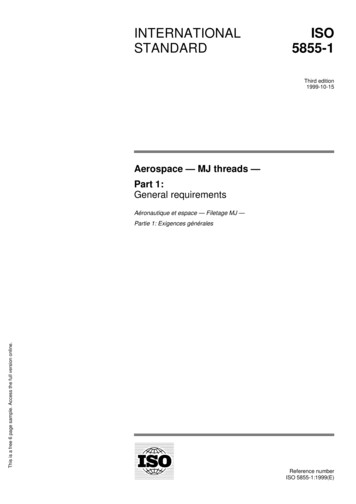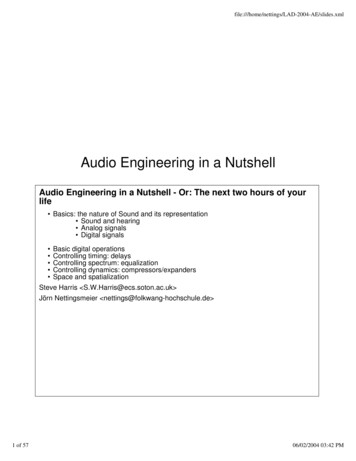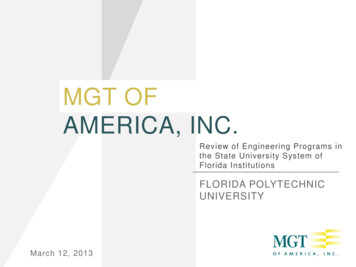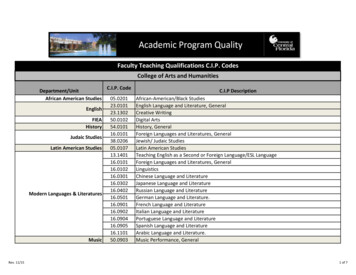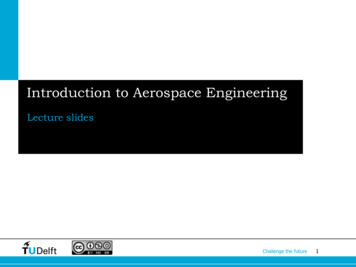
Transcription
Introduction to Aerospace EngineeringLecture slidesChallenge the future1
Introduction Aerospace EngineeringFlight MechanicsDr. ir. Mark Voskuijl15-12-2012DelftUniversity ofTechnologyChallenge the future
3.&4Horizontal flight performanceFlight Mechanics2
Flight mechanicsHours 1Hours 3Hours 5Hours 7Hours 9&&&&&2:4:6:8:10:Introduction, general equations of motionHorizontal flight performanceClimbing and descending flightFlight envelopeExample questions and solutionsFlight Mechanics3
Contents1.2.3.4.5.Summary previous lectureIntroductionEquations of motion horizontal steady symmetric flightPerformance diagramAircraft performance in horizontal flight1.2.3.4.5.Minimum airspeedMaximum airspeedRangeEnduranceSpeed instability / stability6. Summary7. Example exam questionFlight Mechanics4
Equations of motionGeneral equations of motion in symmetric flight (1)Free Body DiagramKinetic DiagrammVLT Xb T D d dtV dVmdtXeWZeZbXbZe XeZbFlight Mechanics 5V
Equations of motionGeneral equations of motion in symmetric flight (2)F madVV : T cos T D W sin mdtd V : L W cos T sin T mVdtFlight Mechanics6
Propulsive forceTypical analytical assumption – JetThrust is assumed to be independent of airspeedFlight Mechanics7
Propulsive forceTypical analytical assumption – PropellerPa is assumed to be constant and independent of airspeedFlight Mechanics8
Propulsive forceAnalytical assumptions - summaryJet: Thrust is (assumed) independent of airspeedPropeller: Power available is (assumed) independent of dFlight Mechanics9
Summary previous lecture You should be able to derive theequations of motion for 2dimensional flight The thrust of a jet aircraft can beassumed independent of airspeed The power available of a propelleraircraft can be assumedindependent of airspeedW dV T cos T D W sin g dtW d F V : g V dt L W cos T sin T F// V:CL2CD CD0 Ae The complete aircraftaerodynamics can be representedby 1 equation; the lift drag polarFlight Mechanics10
Contents1.2.3.4.5.Summary previous lectureIntroductionEquations of motion horizontal steady symmetric flightPerformance diagramAircraft performance in horizontal flight1.2.3.4.5.Minimum airspeedMaximum airspeedRangeEnduranceSpeed instability / stability6. Summary7. Example exam questionFlight Mechanics11
Contents1.2.3.4.5.Summary previous lectureIntroductionEquations of motion horizontal steady symmetric flightPerformance diagramAircraft performance in horizontal flight1.2.3.4.5.Minimum airspeedMaximum airspeedRangeEnduranceSpeed instability / stability6. Summary7. Example exam questionFlight Mechanics12
IntroductionHorizontal flight performance How fast can an aircraft fly? How slow can a given aircraft fly? At what speed should be flown to be able to fly as far as possible?(Interesting for airliners) At what speed should be flown to stay in the air as long aspossible? (Search and rescue, military purposes)Flight Mechanics13
IntroductionWhat to learn?Most important are the lecture sheets!!!Background material:Introduction to Flight (Anderson)Par. 6.1 – 6.2Par. 6.3 – 6.6Par. 6.12 – 6.14Flight Mechanics14
Contents1.2.3.4.5.Summary previous lectureIntroductionEquations of motion horizontal steady symmetric flightPerformance diagramAircraft performance in horizontal flight1.2.3.4.5.Minimum airspeedMaximum airspeedRangeEnduranceSpeed instability / stability6. Summary7. Example exam questionFlight Mechanics15
Equations of motionGeneral equations of motion in symmetric flight (1)Free Body DiagramKinetic DiagrammVLT Xb T D d dtV dVmdtXeWZeZbXbZe XeZbFlight Mechanics 16V
Equations of motionGeneral equations of motion in symmetric flight (2)F madVV : T cos T D W sin mdtd V : L W cos T sin T mVdtFlight Condition:The aircraft is performing a horizontal (straight) and steadyflight.Assumption:The thrust is assumed to be in the direction of flight ( T 0).Flight Mechanics17
Equations of motiondefinitions Straight flight: flight in which the centre of gravity of theaircraft travels along a straight line (d /dt 0) Steady flight: Flight in which the forces and moments acting onthe aircraft do not vary in time, neither in magnitude, nor indirection (dV/dt 0) Horizontal flight: The aircraft remains at a constant altitude( 0) Symmetric flight: flight in which both the angle of sideslip iszero and the plane of symmetry of the aircraft is perpendicular tothe earth ( 0 and the aircraft is not turning)Flight Mechanics18
Flight Mechanics19
Flight Mechanics20
http://www.youtube.com/watch?v TCUHQ -l6QgB52 landing in crosswindFlight Mechanics21
Equations of motionHorizontal, steady, symmetric flightF ma 1 0 0dVV : T cos T D W sin m 1 0 dt 0d V : L W cos T sin T mVdtV :T D V : L WNote: Clearly thisis the most simpleform of theequations ofmotionHow do these forces (aerodynamic, propulsive, gravitational) varywith airspeed?Flight Mechanics22
Contents1.2.3.4.5.Summary previous lectureIntroductionEquations of motion horizontal steady symmetric flightPerformance diagramAircraft performance in horizontal flight1.2.3.4.5.Minimum airspeedMaximum airspeedRangeEnduranceSpeed instability / stability6. Summary7. Example exam questionFlight Mechanics23
Performance diagram For a given altitude, configuration and engine control setting, thedrag or power required and thrust or power available are plottedagainst airspeed Also called Pernaud diagram Very useful to determine aircraft performance parametersFlight Mechanics24
Performance diagram Typical shape:Flight Mechanics25
Performance diagramPa T VPr D VFlight Mechanics26
Jet (thrust / power)Propeller (power)Aerodynamics (power / drag)ForcePowerairspeedairspeedFlight Mechanics27
Contents1.2.3.4.5.Summary previous lectureIntroductionEquations of motion horizontal steady symmetric flightPerformance diagramAircraft performance in horizontal flight1.2.3.4.5.Minimum airspeedMaximum airspeedRangeEnduranceSpeed instability / stability6. Summary7. Example exam questionFlight Mechanics28
Horizontal flight performance Minimum airspeed (How slow) Maximum airspeed (How fast) Range (How far) Endurance (How long) Speed stability / instabilityAssumptions: Horizontal steady symmetric flight( L W, T D, Pa Pr ), except for the speed stability sectionFlight Mechanics29
Contents1.2.3.4.5.Summary previous lectureIntroductionEquations of motion horizontal steady symmetric flightPerformance diagramAircraft performance in horizontal flight1.2.3.4.5.Minimum airspeedMaximum airspeedRangeEnduranceSpeed instability / stability6. Summary7. Example exam questionFlight Mechanics30
Minimum airspeedL WC L 12 V 2S WW 2 1V S CLVmin W 2 1S CLmaxFlight Mechanics31
Minimum airspeedFlapsFlight Mechanics32
Minimum airspeedPerformance diagramVminFlight Mechanics33
Minimum airspeedExample calculation Question: An aircraft has a wing loading (W/S) 2400 N/m2 andCLmax 1.4. Find the airspeed at which stall occurs (minimum airspeed)at (i) sea level ( 1.225 kg/m3) and (ii) at 5000m ( 0.737 kg/m3) Answer:L WCL 12 V 2S WVmin W2 1S CL ,max(i)Vmin 240021 51.8 m/s1.225 1.4(ii)Vmin 240021 66.8 m/s0.737 1.4Flight Mechanics34
Contents1.2.3.4.5.Summary previous lectureIntroductionEquations of motion horizontal steady symmetric flightPerformance diagramAircraft performance in horizontal flight1.2.3.4.5.Minimum airspeedMaximum airspeedRangeEnduranceSpeed instability / stability6. Summary7. Example exam questionFlight Mechanics35
SolutionTmax DMaximum airspeedL WJet aircraftL CDTmax D WL CLCD CD0 k CL2 Pilot applies maximum throttle(max. thrust or Power available)ForceC D0Tmax k CL CLWTkCL2 max CL CD0 0Wax 2 bx c 0Maximum thrust CL .DragVmaxVL W V Flight MechanicsW2 1S CL36
Maximum airspeedExampleThe following data is known of the Cessna Citation II (subsonic jet)Aircraft Weight : W 60 kN,Wing area : S 30 m2,(Parabolic) Lift-Drag polar : CD CDo kCL2; CDo 0.022, k 0.047, CLmax 1.35,Maximum Thrust at 0 m ISA :T0 12 kN.The aircraft is flying at an altitude of H 0 m in the International StandardAtmosphere ( 0 1.225 kg/m3)Thrust is assumed to be independent of the airspeedCalculate (1) the maximum airspeed of this aircraft when flying at H 0 mand (2) the corresponding Mach numberFlight Mechanics37
Maximum airspeedSolutionSteady symmetric horizontal flight:Maximum Mach number?L W, T DWithMmax L CL 12 V 2S, D CD 12 V 2SThrust must be at maximum to achieve VmaxCombining the above yields:CL W 60000C 5 CD LCDT 120005Vmaxaa RT 1.4 287.05 288.15 340.3 m/sMmax 172.1 0.5340.3Lift drag polar:CD CD0 k CL2C L C D0 05kkCL0.022CL2 05 0.047 0.047CL2 CL 0.11Vmax W2 1 S CL60000 21 172.1 m/s30 1.225 0.11Flight Mechanics38
Contents1.2.3.4.5.Summary previous lectureIntroductionEquations of motion horizontal steady symmetric flightPerformance diagramAircraft performance in horizontal flight1.2.3.4.5.Minimum airspeedMaximum airspeedRangeEnduranceSpeed instability / stability6. Summary7. Example exam questionFlight Mechanics39
Range How can we fly as far as possible for a given amount of fuel? How can we fly a given distance with the minimum amount of fuel?Specific range is defined as the ratio V/F, where F equals thefuel flowDimensional analysis: V V m s F F N / s m N Or, put in words, specific range is the distance that can beflown for 1 Newton of fuel. Clearly, this variable must bemaximisedFlight Mechanics40
RangeMaximum range propeller aircraftFc P Pbr F c PPa jPa Pr (steady horizontal flight)F cPPrDV cP j jV j 1 F cP D j and cP can be assumed to be constant as a function of airspeed(over the range of cruising speeds) for propeller aircraft C V Rmax Dmin L F max C D maxFlight Mechanics41
RangeMaximum range propeller aircraftFlight Mechanics42
Problem!Result:Prop: maximum range at maximum CL / CDDear pilot, could you please fly at CL / CD max?We must give an airspeed to the pilotFlight Mechanics43
SolutionCD CD0C L2 AeResult:Prop: maximum range at maximum CL / CDCD f CL d CL dCL CD 0 dCCD 1 CL DdCL 0CD2 y f ( x)d g ( x) hg ' gh ' dx h( x) h2dCD CD dCL CLCL2CD0 2CL Ae AeCLCL CD0 AeL WW 2 1V S CLFlight Mechanics44
RangeExample: Spirit of St. Louis Charles Lindbergh (1927) First solo, non stop flight across theAtlantic oceanFlight Mechanics45
Performance diagramSpirit of St Louis(ref: NASA)Note:The Pr curve shiftsdown when weightdecreases. This meansthat Charles had todecrease airspeedduring the flightFlight Mechanics46
Contents1.2.3.4.5.Summary previous lectureIntroductionEquations of motion horizontal symmetric flightPerformance diagramAircraft performance in horizontal flight1. Minimum airspeed2. Maximum airspeed3. Range1. Propeller2. Jet4. Endurance5. Speed instability / stability6. Summary7. Example exam questionFlight Mechanics47
RangeJet aircraftSo, at what speed should the pilot fly to maximise specific range?FcTTTypically, cT can be considered to be constantT DF cTT cT DVV F cT D VF max V D max D V minFlight Mechanics48
RangeJet aircraftPerformance diagram (jet) D D 1 V L LV max maxL W CD1 D W V max C L V maxC L 12 V 2S W V D CD WVCL1W 2 1S CL W 2 1S CLWW 2 CLS C D2 CL D V C 2 min D maxFlight Mechanics49
Problem!Result:Jet: maximum range at maximum CL / CD2Dear pilot, could you please fly at CL / CD2 max?We must give an airspeed to the pilotFlight Mechanics50
SolutionCD CD0C L2 AeResult:Jet: maximum range at maximum CL / CD2CD f CL d CL dCL CD2 0 CD2 1 CL 2CDCdCDdCL4DdCD 1 CD 2dCLCLCL2C 2CL 1 D0 Ae Ae 2CLCL 13CD0 Ae y f ( x) d g ( x) hg ' gh ' dx h( x) h2 0L WW 2 1V S CLFlight Mechanics51
How environmentally (un)friendly areaircraft? Example: Boeing 747: W 3000 kNS 510 m2b 60 mhcr 11000 mMcr 0.85 Estimated: CD0 0.02; e 0.85; tot 0.40Flight Mechanics52
How environmentally (un)friendly areaircraft really W/S 5882 N/m2; A 7.06 a 295 m/s; V 250 m/s ( 900 km/hr)W 2 1 0.517S V 2C L2CD CD 0.0342 AeCL 15.1CDCD D W 198.4 kNCLPa Pr DV 49591 kJ/sCL 0Flight Mechanics53
How environmentally (un)friendly areaircraft really? tot F Pa 0.40 estimated (in the order of efficiency power plant)Qg Pa 28.3 N/sH totH 43000 kJ/kg fuel 0.8 kg/m3Fuel consumption: 12980 l/hr (in accordance with data manufacturer)Every hour 900 km is travelled and 12980 l of fuel is used:69 m/lWith 400 passengers: 27.7 pax km/lFlight Mechanics54
Comparison to a car Car driving 1:15 and 4 passengers: 60 pax km/l Conclusion: consumption of car is half the consumption of a 747despite the speed ratio 9:1 In practice ( seat occupation 100% ) consumption perpassenger km is similar for car and aviation trafficFlight Mechanics55
Contents1.2.3.4.5.Summary previous lectureIntroductionEquations of motion horizontal symmetric flightPerformance diagramAircraft performance in horizontal flight1.2.3.4.5.Minimum airspeedMaximum airspeedRangeEnduranceSpeed instability / stability6. Summary7. Example exam questionFlight Mechanics56
Endurance Endurance: time duration spentin flight Do not confuse endurance withrange! Solution: maximum endurance forminimum fuel flow FminFlight Mechanics57
EnduranceJet aircraftFTF cT TcT Performance diagram (jet)Horizontal steady flightT DF cT DAssumption: c T constantFmin D min CL C D maxFlight Mechanics58
EndurancePropeller aircraftPF F cP aPbr jPa Pr (steady horizontal flight)PDVF cP r cP j jcP F cPD W 2 1 j S CLcP CDW 2 1 c P W 3 2 C D2F W j CLS C L j S C L3 j and cP can be assumed to be constant as a function of airspeed(over the range of cruising speeds) for propeller aircraftE max Fmin C L3 2 DVC D max min Pr ,minFlight Mechanics59
EndurancePropeller aircraftPr should be minimal!Flight Mechanics60
Problem!Result:Propeller: maximum endurance atmaximum CL3 / CD2Dear pilot, could you please fly at CL3 / CD2 max?We must give an airspeed to the pilotFlight Mechanics61
SolutionCD CD0C L2 AeResult:Prop: maximum endurance at maximum CL3 / CD2CD f CL d CL3 dCL CD2 0 CD2 3CL2 CL3 2CDCdCDdCL4DdCD 3 CD 2dCLCLCL2C 2CL 3 D0 Ae Ae 2CLCL 3CD0 Ae y f ( x) d g ( x) hg ' gh ' dx h( x) h2 0L WW 2 1V S CLFlight Mechanics62
Contents1.2.3.4.5.Summary previous lectureIntroductionEquations of motion horizontal symmetric flightPerformance diagramAircraft performance in horizontal flight1.2.3.4.5.Minimum airspeedMaximum airspeedRangeEnduranceSpeed instability / stability6. Summary7. Example exam questionFlight Mechanics63
Speed instability General equations of motionF madVdtd V : L W cos T sin T mVdtV : T cos T D W sin m Equations of motion horizontalsymmetric flight (thrust parallelto airspeedF maV :T D mdVdt V : L WFlight Mechanics64
Speed instabilityForceDisturbance (gust of wind for example)D TT - D mdV/dtdV/dt 0ThrustDragVdesiredAirspeedConclusion: the aircraft is ‘speed unstable’ and will deviate from the original positionfollowing a disturbance. This makes it difficult for the pilotFlight Mechanics65
Speed stabilityForceDisturbance (gust of wind for example)D TT - D mdV/dtdV/dt 0ThrustDragVdesiredAirspeedConclusion: the aircraft is speed stable and the aircraft will automaticallyreturn to the original airspeed. Very nice for the pilot!Flight Mechanics66
Speed stability - instabilityForceDragAirspeedSpeed unstableSpeed stableFlight Mechanics67
Contents1.2.3.4.5.Summary previous lectureIntroductionEquations of motion horizontal symmetric flightPerformance diagramAircraft performance in horizontal flight1.2.3.4.5.Minimum airspeedMaximum airspeedRangeEnduranceSpeed instability / stability6. Summary7. Example exam questionFlight Mechanics68
Summary - JetForceMax thrustDragAirspeedMin. speedCL,maxMax. Endurance(CL / CD)maxMax. Range(CL/CD2)maxMax. Speed(dependson Tmax)Flight Mechanics69
Summary – Propeller AircraftPowerPower availablePower requiredAirspeedMin. speedCL,maxMax. Endurance(CL3 / CD2 )max Max. Range(CL/CD)maxMax. Speed(dependson Pamax)Flight Mechanics70
Summary – Horizontal flightL WT DMinimum airspeedCL ,maxVmin W 2 1S CL ,maxVmax W 2 1S CLMaximum airspeedTmax D (Jet)CL .Pa ,max Pr (Prop)Maximum range V F maxjetprop CL 2 CD maxCL CL C D maxCL CD0 Ae13CD0 AeV Flight MechanicsW 2 1S CL71
Summary – Horizontal flightL WT DMaximum endurancejet CL CD maxCL CD0 Ae F minV prop C L3 2 CD maxW 2 1S CLCL 3CD0 AeFlight Mechanics72
Contents1.2.3.4.5.Previous lecture – Propeller - simplificationIntroductionEquations of motion horizontal symmetric flightPerformance diagramAircraft performance in horizontal flight1.2.3.4.5.Minimum airspeedMaximum airspeedRangeEnduranceSpeed instability / stability6. Summary7. Example exam questionFlight Mechanics73
Example exam question (homework)ProblemThe Gulfstream IV, indicated in Figure 1 is a twin-turbofan executive transport aircraft.Data for this aircraft are given below:S 88.3 [m2]b 23.7 [m]A 6.36 [-]e 0.67 [-]CD0 0.015 [-]CD CD0 CL2 / AeW 311000 [N]This aircraft has two Rolls Royce Tay turbofan engines. Fuel consumption can berepresented with the following equation: F cTT, where cT 0.69 [N/hr/N]. The thrustspecific fuel consumption is assumed to be independent of airspeed and altitudeQuestion:What is the maximum specific range of this aircraft when flying at 8000m (ρ 0.5252kg/m3) ?Flight Mechanics74
Example exam question (homework)Solution (part 1)Specific range V/F (m/kg) V/cTTSteady horizontal flight: T D; L WV/F V/cTDcT is a constant so maximum specific range when (D/V) is minimalL CD D DWL CLV W 2 1S CLD CD WV CL1W W 2 1W 2 CLS CLS CD2So CL / CD2 should be maximal. This is the case when CL (CD0 Ae/3 )(you should derive this on the exam, see sheet 48)CL 13 0.015 6.36 0.67 0.26CL20.262CD CD0 0.015 0.02 Ae 6.36 0.67Flight Mechanics75
Example exam question (homework)Solution (part 2)From the lift coefficient, we can calculate the airspeedV W 2 1311000 21 227 [m/s]S CL88.3 0.5252 0.26The aerodynamic drag can be calculated with the drag coefficient. This must be equal to the thrustT D CD0.02W 311000 23.9 [kN]CL0.26Now, all parameters are known to calculate the maximum specific range for thisaltitude and aircraft weightVV227 50 [m/N]F cT T (0.69/3600) 23900Flight Mechanics76
Flight Mechanics 3 Flight mechanics Hours 1 & 2 : Introduction, general equations of motion Hours 3 & 4 : Horizontal flight performance Hours 5 & 6 : Climbing and descending flight Hours 7 & 8 : Flight envelope Hours 9 &
